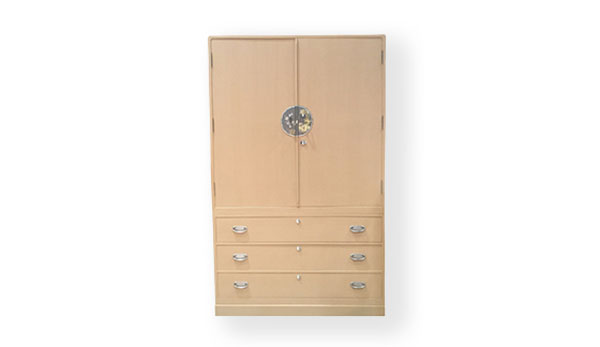
- Wood, bamboo crafts
- Saitama
Kasukabe traditional paulownia chest Kasukabe kiri tansu
Feel the warmth of the wood grain
with traditional techniques
Description
What is Kasukabe traditional paulownia chest ?
Kasukabe traditional paulownia chests, called Kasukabe Kiri-tansu in Japanese, are traditional woodwork made around Saitama City and Kasukabe City, Saitama Prefecture. Kasukabe Kiri-tansu are distinguished by their simple design based on the straight lines of wood, and by not using iron nails, the feeling of a natural wood article is carefully preserved. The warm design utilizing the beautiful wood grain of paulownia still continues to be loved by many people today. The paulownia used to make Kasukabe Kiri-tansu has excellent moisture-barrier and flame-retardant properties, and is light in weight compared to other types of wood. Paulownia wood expands when the weather is humid and contracts when dry. This property makes it ideal for safely storing clothes which are badly affected by humidity. Paulownia is also renowned for being flame-retardant, making Kasukabe Kiri-tansu an excellent choice for storage compared to chests made of other wood.
History
A group of artisans building the Nikko Toshogu shrine from 1624 to 1644 settled in Kasukabe, and started to make small boxes. This is thought to be the origin of Kasukabe Kiri-tansu. When Kasukabe Kiri-tansu were first made, many artisans made them only in the quiet farming season as a supplementary income, and there were only a few joiners who made tansu fulltime. However, everything changed around 1830 with the opening up of the Furutone and Edo Rivers to transport goods to Edo, the prosperous capital city of Japan. At that time, there were an increasing number of joiners who were specialized in making Kiri-tansu. In the Meiji period, as transportation improved, the market was expanded to a wider area, including Osaka, Hiroshima, and Fukuoka beyond Tokyo, and as a result, Kasukabe Kiri-tansu became known across the whole country. At present, the traditional form of Kasukabe Kiri-tansu still continues to find a place in modern life as an elegant interior accessory.
General Production Process
- 1. Cutting raw timber Paulownia of excellent quality is grown across the Tohoku region, and wood mainly from Aizu in Fukushima Prefecture is used as the raw material of Kasukabe Kiri-tansu. Other than paulownia, Japanese big-leaf magnolia and mulberry wood grown in Hokkaido are also used as supplementary materials. Trees are carefully inspected and cut ready for sawing. Very careful consideration is given to ensure the best use of each log. The thickness of the wood planks is 9 to 21 mm for standard grade wood used for side plates and drawer cases, and 5.5 mm for the higher grade straight-grained wood which has been divided into four pieces.
- 2. Drying The cutout materials are placed on top of each other in a double cross, and exposed to wind and rain to dry naturally for three to four months. Natural drying is important to remove substances that cause discoloration from the wood. This process brings out the beauty of the flesh color of the wood unique to Kasukabe Kiri-tansu.
- 3. Preparing the timber The timber is cut to size a little larger than the actual dimensions. At this time, straight-grained boards used on the surface of the chests are adjusted so the lines of wood grain match. This adjustment allows Kasukabe Kiri-tansu to be finished with a balanced and beautiful wood grain. The boards are also marked at this stage to make sure they are arranged correctly for a beautiful finish.
- 4. Warp correction Any warped boards are heated over a fire one by one, and warps are corrected with a plane. This task is delicate and requires much skill. It is said to take at least three years to master this warp correction technique.
- 5. Planing When the warps have been removed the cutout boards are still a little larger than the actual dimensions. The boards are planed at this stage to fit to size.
- 6. Assembly After planing to size, the components are assembled. Nails made of strong and durable deutzia wood are used. The wood nails are strong, but obviously not as strong as metal, so holes are first drilled in the boards and the wooden nails are hammered in.
- 7. Finishing The assembled chest is adjusted by using water to correct any warping. With careful adjustments, drawers and doors can be opened and closed smoothly. This is an important process to ensure everything works well. Any further fine adjustments are made with a plane. After making adjustments, it is polished with a special brush made from dried cogon grass roots to bring out the wood grain. Next a mixture of polishing powder and Japanese green alder dye is applied for coloring. Finally, the chest is waxed for water resistance and is given a final polishing. Fittings are attached, an overall adjustment is made and the Kasukabe Kiri-tansu is complete.
See more Wood, bamboo crafts
- Hakone wood mosaic
- Iwayado traditional chest
- Kaba cherrybark woodcrafts
- Odate bentwood
- Inami wood carvings
- Matsumoto furniture
- Beppu bamboo crafts
- Edo wood joinery
- Ichii woodcarvings
- Suruga bamboo crafts
- Edo bamboo fishing rods
- Kishu bamboo fishing rods
- Kamo traditional chest
- Kyo wood joinery
- Miyakonojo archery bows
- Osaka carved wooden panel
- Miyajima woodwork
- Nibutani carved wooden tray
- Okuaizu Basketry
- Echizen traditional chest
- Kasukabe traditional paulownia chest
- Katsuyama bamboo crafts
- Osaka karaki wood joinery
- Takayama tea whisks
- Toyooka wicker crafts
- Akita cedar tubs and barrels
- Nagiso woodturning
- Kishu traditional chest
- Nagoya traditional paulownia chest
- Osaka bamboo screens
- Osaka-senshu traditional paulownia chest
- Sendai traditional chest































































































































































































































































































